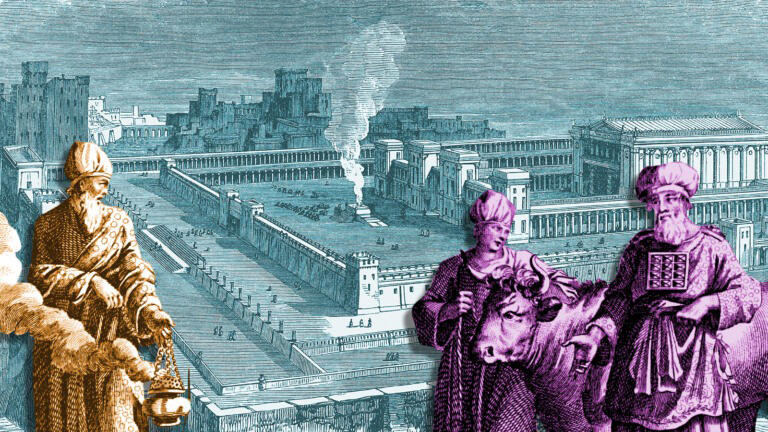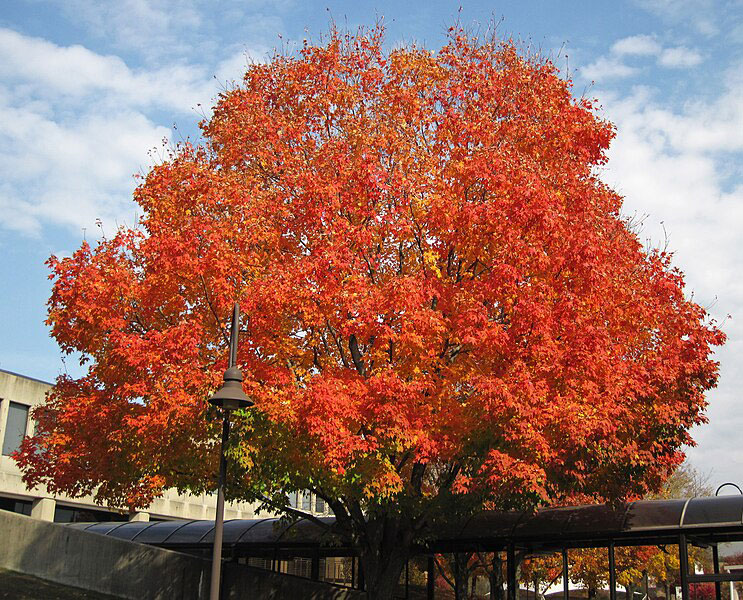(MyJewishLearning) — Long ago, as prescribed by the Hebrew scriptures, Jewish worship revolved around the Temple in Jerusalem. For a thousand years, the Temple was a hub for offering sacrifices of all sorts (peace offerings, thanksgiving offerings, atonement offerings and more) every day of the year. On the three annual pilgrimage festivals — Passover, Shavuot and Sukkot — all Israel was invited to ascend to Jerusalem to offer special sacrifices and celebrate. The Temple also served as an important administrative center of the Jewish people.
All this came to a screeching halt in 70 CE when the Temple was destroyed in a devastating war with the Romans. In its wake, rabbinic Judaism (the Judaism practiced by virtually all Jews today) and its central text, the Talmud, laid the foundation for Jewish ritual and worship in a world without the Temple.
Though the Temple is long gone, it is far from forgotten. The construction of the Temple is described in great detail in the Hebrew Bible, and its practices are meticulously documented and parsed in the Talmud. An entire annual holiday — Tisha B’Av — is given over to mourning its absence from Jewish life. And a piece of the Temple — the western retaining wall of the platform on which it stood, called the Kotel or Western Wall — is today one of the holiest sites for Jews.
Even though remembering the Temple remains a central part of Jewish practice today, it can be difficult to grasp just how central the Temple was to ancient Jewish life. Here are 7 facts that help illustrate what the ancient Temple was really like, and what it has meant to Jews throughout history.
1. There were actually two Temples on the same spot
The first Temple, built by King Solomon in approximately 1000 BCE, was destroyed by the Babylonians in 586 BCE. When the Persians conquered the Babylonians almost a century later, they agreed to let the Jewish leaders who had been taken into exile return to the land of Israel where they would rebuild the Temple. This Second Temple stood for hundreds more years, then was thoroughly renovated and expanded by Herod the Great in the last few decades before the beginning of the Common Era. The Second Temple was destroyed by the Romans in 70 CE.
According to Jewish tradition, both Temples were destroyed on the ninth day of the month of Av. Tisha B’Av (literally: Ninth of Av) commemorates the destruction of both Temples, as well as other disasters in Jewish history, both ancient and modern.
2. The Temple was built on a mountain that goes by many names
Jerusalem is in the hill country. The Temple was situated on one particular rise that goes by many names in the Hebrew scriptures. The Torah never identifies the mountain, but simply talks about “the place God will choose to rest His name” (e.g. Deuteronomy 12).
The specific mountain is identified in Isaiah and the Book of Psalms as Mount Zion (e.g. Isaiah 60:14, Psalms 125:1). The biblical Book of Chronicles, however, calls it Mount Moriah (2 Chronicles 3:1). Micah 4:1 refers to it generically as Har Beit Adonai — meaning “The Mount of the House of the Lord.” Jeremiah 26:18 shortens this to Har HaBayit, “The Mountain of the House,” commonly translated as the Temple Mount. This last name, Temple Mount, is used frequently in the Mishnah and Talmud and other rabbinic literature.
3. The Temple stood on the spot where the world began
According to the Talmud, on the top of Mount Moriah is a foundation stone from which God created the whole world (Yoma 54b). This same foundation stone later lay under the Holy of Holies, the most sacred room of the Temple. Ancient interpreters also believed that more than a millennium before the Temple was built, the stone was the site of the Binding of Isaac.
4. The exact location of the Temple is still debated today
The Temple definitely stood on the Temple Mount — that has always been an agreed fact and has been confirmed by archaeologists. However, where exactly it stood is a matter of debate. Some believe that it was in the exact location of the Dome of the Rock, a Muslim shrine (highly recognizable on the Jerusalem skyline) which houses the foundation stone. Another view agrees with a statement in the Talmud (Berakhot 54a) which says it was aligned with the Eastern Gate, which would place it slightly north of the Dome of the Rock. There is also a theory that it was situated slightly east of the Dome of the Rock.
5. After the First Temple was destroyed, the priests returned the keys to God
Taanit 29a describes a remarkable scene that took place as the First Temple was being destroyed by the Babylonians:
When the Temple was destroyed for the first time, many groups of young priests gathered together with the Temple keys in their hands. And they ascended to the roof of the Sanctuary and said before God: Master of the Universe, since we did not merit to be faithful treasurers, and the Temple is being destroyed, let the Temple keys be handed to You. (Taanit 29a)
The priests’ final act of divine service was to throw the keys up to heaven, where a divine hand reached out of the clouds to catch them. Then the priests threw themselves into the flames consuming the Temple.
6. The Temple was enormous
Picturing something the size of a synagogue? Not even close. In the first century, when Herod renovated the Temple, he began by building a retaining wall around the Temple Mount and then constructing a platform over the top, turning the mount into a four-sided plateau 37 acres in area.
The Temple complex itself contained a series of courtyards surrounding the central room, the Holy of Holies, which was only entered once a year, on Yom Kippur, by the high priest. In addition to the large courtyards and Holy of Holies, the Temple complex contained many other storage and administrative rooms, plus numerous ritual baths for purification. The whole system was fed by an aqueduct that brought water from 10 kilometers away, and it was protected by high walls and a series of gates.
To get a sense of the scale, consider that the Kotel, the famous Western Wall that is a central Jewish holy site, is what remains of just a piece of the western side of the retaining wall built around the Temple Mount.
7. The Temple was messy — and smelly
The primary purpose of the Temple and its staff (the priests and Levites) was to offer sacrifices to God. It was open for business 365 days a year. Many of these sacrifices were animals that were brought live into the Temple and slaughtered in the courtyard before some or all of their flesh and/or blood was offered on the altar. On pilgrimage festivals, all of Israel came from near and far to offer sacrifices. As a result, the courtyard of the Temple ran almost constantly with animal blood, while the smell of sacrifices on the fire probably pervaded most of Jerusalem. (The smell was largely the point — that fragrant smoke is what went up to God.)
Some sacrificial blood was carefully collected and sprinkled on the altar as part of the ritual. Much of it, however, was rinsed away via channels that were built into the floor and conducted it out to the nearby Kidron River. The water of this river, enriched by this blood, was sold to farmers as fertilizer (Mishnah Yoma 5:6). Despite this impressive ancient plumbing system, the Temple stones required regular deep cleaning. Mishnah Middot chapter 3 indicates that there was also a schedule for whitewashing the stones of the Temple, as well as the altar and ramp leading up to it.





